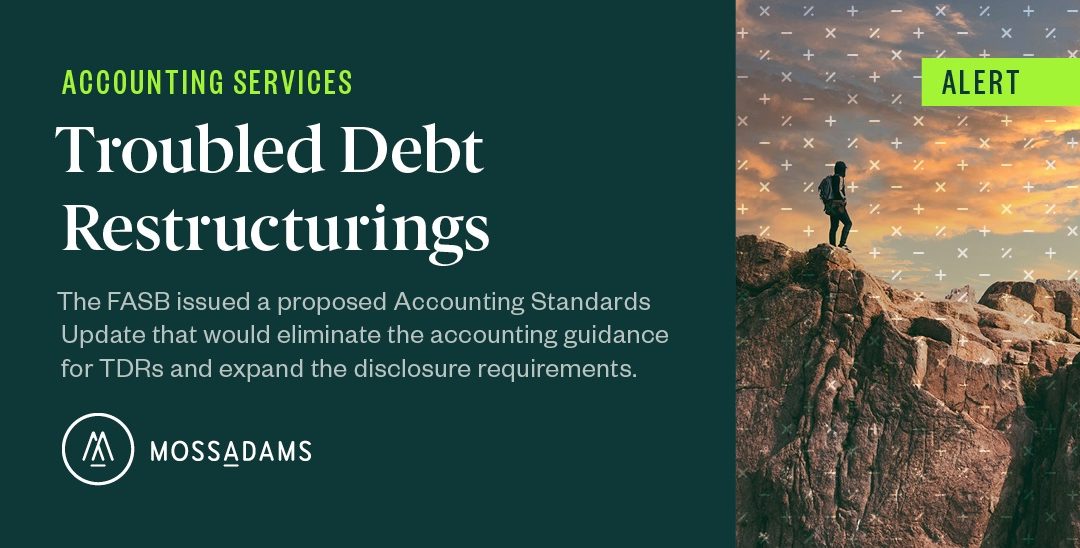This article, "FASB Proposes to Eliminate Accounting Guidance for Troubled Debt Restructurings," originally appeared on MossAdams.com.
The Financial Accounting Standards Board (FASB) has issued proposed Accounting Standards Update (ASU), Financial Instruments—Credit Losses (Topic 326): Troubled Debt Restructurings and Vintage Disclosures.
The proposed ASU intends to improve the decision usefulness of information investors receive about certain loan refinancings, restructurings, and write-offs.
Comments are due by December 23, 2021.
Scope
The proposed amendments which relate to troubled debt restructurings (TDRs) would affect all entities after they adopt ASU 2016-13, Financial Instruments—Credit Losses (Topic 326): Measurement of Credit Losses on Financial Instruments.
The proposed amendments which relate to vintage disclosures would affect public business entities with investments in financing receivables that adopt ASU 2016-13.
Key Provisions
The proposed amendments address areas identified by the FASB as part of its Post-Implementation Review of ASU 2016-13, referred to as the current expected credit losses (CECL) standard.
Troubled Debt Restructurings
The guidance in ASU 2016-13 introduced the CECL model, which requires entities to measure all expected credit losses for financial instrument held at the reporting date.
The CECL standard also retained the designation and related disclosure requirements for TDRs by creditors provided in Subtopic 310-40, Receivables—Troubled Debt Restructurings by Creditors.
This means that under the current guidance in ASU 2016-13, credit losses from loans modified as TDRs are incorporated into the allowance for credit losses under the rules of Subtopic 310-40 and not the principals of Topic 326.
Post-Implementation Review
During the post-implementation review, stakeholders questioned the relevance of the additional TDR designation of a loan modification.
They noted that the accounting and disclosure of TDRs is unnecessarily complex and no longer provides decision-useful information as the measurement of expected losses under the CECL model incorporates the forward-looking aspects of the TDR model.
Proposed Updates
As a result, the proposed amendments would eliminate the accounting guidance for TDRs by creditors in Subtopic 310-40.
Instead of applying the recognition and measurement guidance for TDRs, after an entity adopts ASU 2016-13 it would apply the loan refinancing and restructuring guidance in Subtopic 310-20, Receivables—Nonrefundable Fees and other Costs to determine whether a modification results in a new loan or a continuation of an existing loan.
Under the proposed amendments, an allowance for credit losses for loans modified to borrowers experiencing financial difficulties would be determined under Topic 326 instead of Subtopic 310-40.
Disclosures
The proposed amendments would also enhance the disclosure requirements for loan refinancings and restructurings by creditors when a borrower experiences financial difficulty.
The proposed disclosure requirements would apply to modifications that are accounted for as a:
- New loan
- Continuation of an existing loan
For modifications of receivables made to debtors experiencing financial difficulty during the reporting period, the proposed amendments would require disclosure—by class of financing receivable—of quantitative and qualitative information about:
- The types of modifications provided, including the amount of receivables modified and the percentage of modifications made to debtors experiencing financial difficulty to total loans
- The expected financial effect of the modification by type of modification
- The performance of the loans after modification
The proposed amendments would also require disclosure—by portfolio segment—of qualitative information about how the modification and the debtors’ subsequent performance factor into determining the allowance for credit losses.
As of the date of each balance sheet presented, the creditor must disclose the amount of commitments to lend additional funds to debtors experiencing financial difficulties when the creditor has modified the terms of the receivables in the current reporting period.
In addition to the above disclosure requirements, the creditor should also consider providing information that helps financial statement users understand significant changes in the type or magnitude of modifications.
Vintage Disclosures
ASU 2016-13 requires public business entities to present the amortized cost basis of financing receivables and net investment in leases within each credit quality indicator by year of origination—vintage year.
An illustration within ASU 2016-13 provides an example of how a public business entity may meet the disclosure requirement to present financing receivable information by year of origination—commonly referred to as the vintage disclosures. This illustration currently includes a line item for gross write-offs and gross recoveries for each origination year.
Due to the inconsistency between the guidance and illustration, stakeholders indicated that it was unclear whether the vintage disclosure had to present both gross write-offs and gross recoveries.
Proposed Updates
To address this feedback, the proposed amendments would clarify that a public business entity must only disclose current-period gross write-offs by year of origination for financing receivables and net investment in leases.
Further, the illustration would no longer include the gross recoveries line item.
We’re Here to Help
For more information on how the proposed amendments could affect your business, contact your Moss Adams professional or visit our Accounting Services.


